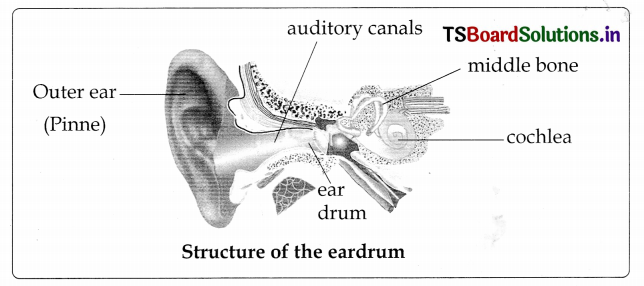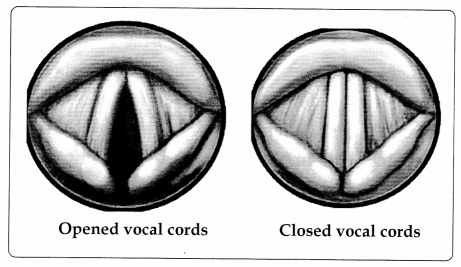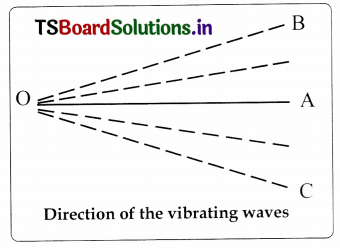These TS 8th Class Physical Science Important Questions 5th Lesson Metals and Non-Metals will help the students to improve their time and approach.
TS 8th Class Physical Science Important Questions 5th Lesson Metals and Non-Metals
Question 1.
How are these sounds produced?
Answer:
Due to the vibrations of moving bodies, these sounds are produced.
Question 2.
How do sounds travel from one place to another?
Answer:
Sounds travel from one place to another through air.
Question 3.
Are we able to hear all sounds in nature?
Answer:
No, we can not hear all sounds in nature. Only some sounds are heard in nature.
Question 4.
Why there is a difference between the sounds produced by various Instruments?
Answer:
Some instruments produce sounds by vibrating stretched membranes. Some instruments produce air inside the hollow body.
![]()
Question 5.
Which part of these instruments is responsible for production of sound?
Answer:
Air, thin membranes are responsible for production of sound.
Question 6.
Can you name the instrument for which more than one part Is responsible for the production of sound?
Answer:
Harmonium and drum.
Question 7.
How do you compare the production of sound in a flute and sound from the holes of a telephone pillar during wind blow?
Answer:
We can’t see any vibrations in the flute. But in holes of the el the telephone pillar, we observed the vibrations.
Question 8.
Write about two famous Indian musicians. (Appreciation/Collect information from your parents or teachers/Information skill)
Answer:
Bismillah Khan, the most oußtanding and world-famous shehnai player, had attained astonishing mastery over the instrument He was born in a small village in Bihar about 80 years ago.
He spent his childhood in the holy city of Varanasi, on the banks of the river Ganga, where his uncle was the official shehnai player in the famous Visvanath temple.

Chitti Babu : (October 13, 1936. February 9, 1996) was a renowned classical musician from India, and arguably one of the greatest Veena artists, in the field of Carnatic Music, a speciality of South India. He became a legend in his own lifetime. His name was synonymous with the musical instrument Veena, and he still is known in the Carnatic Music world, simply as Veena Chitti Babu.

Question 9.
Imitate the different sounds made by animals. Try to mimic your friends. While making these sounds, place your fingers on your throat. What do you feel? Do your fingers sense any vibrations? Are the vibrations same for all the sounds that you make?
Answer:
If we place our finger on throat, we feel the sen of vibrations of throat. For different sounds, the vibrations on throat are different.
![]()
Question 10.
Sketch the diagram of anatomy of the larynx and label its parts.
Answer:

Question 11.
Sketch larynx and explain its function In your own words.
Answer:
- In humans, the sound produced by the voice her or the larynx.
- It is situated in the throat.
- Below to it is the windpipe.
- The two vocal cords are stretched across the voice box or Larynx in such a way that it leaves a narrow slit between them for the passage of air when the lungs force air through the slit, the vocal cords vibrate and the vibration results in sound.

Question 12.
Draw the structure of vocal cords showing open and closed conditions.
Answer:

Question 13.
Why the voice of men, women and children are different?
Answer:
- The vocal cords in men’s art’ about 20mm long,
- In women, these cords are about 5 mm shorter with respect to men.
- Children have very short vocal cords.
- That is the reason that the voice of men, women and children are different.
Question 14.
Length of vocal cords in men Is nearly 20mm, In women it Is about 5mm less, whereas in children It Is some more shorter. Can we say that the length of vocal cords plays any role in deciding the quality of sound produced by men, women and children?
Answer:
Yes, quality of sound produced by men, women and children depends on length of the vocal cords. As a person grows his / her quality of sound changes due to Opened vocal cords Closed vocal cords the change in length of vocal cords.
Question 15.
Collect information about ventriloquism.
(or)
How do you appreciate ventriloquists? (Information skill/Appreciation)
Answer:
Ventriloquists make sounds or talic with hardly any movement of lips. Lips are slightly separated. The various sounds are spoken quickly can be difficult for listeners to notice the difference. They have a very good control over breathing and movement of lips.
throat and the muscles of mouth which aids in pronunciation and deliver of speech without much movement of lips and throat. They let the breath out of the mouth by vibrating their lips in accordance to the air supply and relax muscles while doing this. This is one of the most effective vocal activities.
In Andhra Pradesh, Chinchapattana Gomatham Srinivas from Warangal district is the most famous ventriloquist. He has performed more than 6000 shows around the world. He created a sensational world record by performing a 32 hour non – stop mimicry show in 1990.

![]()
Question 16.
How do you appreciate mimicry artists?
(or)
Collect information from the internet about any mimicry artist from our state. (Appreciation/Information skill)
Answer:
Mimicry:
The mimicry artists maintain a very good control over their voices. The magic they create is solely with their voice. They exercise their vocal parts to keep them fit and be able to enthrall the audience through their voice. Dr.Nerella Venu Madhav is a world famous mimicry artist. He belongs to Warangal district of Telangana state. Govt. of India honoured him with a Padma Shree in 2001.

Question 17.
Sketch the diagram of eardrum.
Answer:

Question 18.
What is eardrum? How does it play an important role in hearing?
Answer:
- We hear sound through our ears.
- The shape of the outer part of ear is like a funnel.
- When sound enters in it, it travels lown a canal at the end of which a thin membrane is stretched tightly.
- It is called the eardrum. It performs an important function.
- The eardrum is like a stretched rubber sheet. Sound vibrations make the eardrum to vibrate.
- The eardrum sends vibrations to the inner ear. From there, the signal goes to the brain. That is how we hear.
Question 19.
What difference do you find in amplitude of vibration for a feeble and a lound sound in the above experiment?
Answer:
If amplitude increases ve can hear loud sound, if amplitude decreases we can hear feeble sound.
Question 20.
Here are some common sounds on their decibel ratings:
Answer:
- Near total silence – 0 dB
- A whisper – 15 dB
- Normal conversation – 60 dB
- A lawnmower – 90 dB
- Acarhorn – 110 dB
- A rock concert or a jet engine – 120 dB
- A gunshot or firecracker – 140 dB
Problems: From the above data, compute the following.
Question 21.
How many times is a car horn more powerful than normal conversation?
Answer:
The decibel rating of a car horn is 110 dB. The decibel rating of a normal conversation is 60 dB. The difference between them is 50 dB. So a car horn is 105 times i.e 1,00.000 times more powerful than normal conversation.
Question 22.
How many times is a jet engine more powerful than a whispering sound?
Answer:
The decibel rating of jet engine is 140 dB. The decibel rating of whispering sound is 15 dB. The difference between them is 125 dB. So sound ola jet engine is 1012 times of powerful than whispering sound.
![]()
Question 23.
What is the unit of the loudness of sound? Explain giving the loudness of few sounds.
Answer:
The loudness is expressed in a unit called decibel (dB). It is essentially a ratio if the actual loudness to some base loudness level. The base level is usually defined as that loudness of sound that the human ear can just perceive. The following table gives some idea of the loudness of sound coming from various sources.
| Normal breathing | 10 dB |
| Soft whisper (at 5m) | 30 dB |
| Normal conversation | 60 dB |
| Busy traffic | 70 dB |
| Average factory | 80 dB |
At 80 dB the noise becomes physically painful.
Question 24.
A bird makes high pitch sound and a lion makes low pitch roar. Which one produces the sound of more frequency?
Answer:
If the frequency of vibration is higher. we say that the sound has a higher pitch. Bird produces the sound of more frequency that lion because bird makes high pitch sound.
Question 25.
Give some more examples of natural sounds that you come across in your daily life and differentiate them as low-pitch sounds and high-pitch sounds.
Answer:
A whistle has a high frequency and therefore produces a sound of higher pitch. whereas the drum vibrates with a low frequency and thus produces a low pitch Sound.
Question 26.
Pitch of the voices of the following in ascending order.
Lion < adult man < adult woman < Child < infant < insect
Answer:
Pitch of the voices of the following in ascending order :
Lion < adult man < adult woman < Child < infant < insect.
The frequency of sound produced by insects is more than the frequency of lions.
Order of frequency of sound in descending order:
Insect> infant > child > adult woman > adult man > lion.
Question 27.
Why do we produce sounds with different pitches or amplitudes, while speaking?
Answer:
The variations in pitch and amplitude of sound during our speech helps us to communicate with others in the form of language.
Question 28.
How do you feel when you hear sounds in busy traffic?
Answer:
I feel uneasy when hear the sound in busy traffic.
![]()
Question 29.
How do you feel while listening to songs from a radio?
Answer:
I feel happy when I listen to the songs from a radio.
Question 30.
Give some examples for pleasant and unpleasant sounds.
Answer:
Pleasant sounds:
- Sound produced by sitar, violin and drum
- Sound from tabala.
- Sound of musical notes.
Unpleasant sounds:
- Sounds produced by machines in a factory
- Moving trains in the traffic at a busy crossing.
- Horns by trucks and buses.
- Sound produced by an explosion.
Question 31.
Do we hear the sounds produced by bats?
Answer:
No. I can not hear the sounds produced by bats.
Question 32.
Collect information from your parents / Internet about M.S. Subbulaxmi and Ghantas. ala Venkateswara Rao.
Answer:
M.S. Suhhalaxmi was famous for her melodious music. It would be difficult to overstate the talent and the impact made by Smt. MS. Suhhulakshmi, not just in the field of Carnatic music, but also as a philanthropist and a person who placed her life at the service to the country and people. She rendered her voice to devotional songs.

Chantasala Venkatess’ar Rao was a famous playback singer. He was famous fer his melodious voice. He sang more than 10,000 songs in Telugu, Tamil, Kannada and Malayalam and worked as a music director for over 100 films, His private songs were equally popular and his devotional songs are popular even today.

Question 33.
Lightning and thunder take place in the sky at the same time and at the same distance from us. Lightning is seen earlier and thunder ¡s heard later. Can you explain why?
Answer:
Light travels at the speed of 3 10’ rn/s while sound travels at a speed of 332 m/s i.e., light travels much faster than sound that is why lightning is seen earlier and thunder is heard later.
Question 34.
What are the harms of noise pollution? (Conceptual understanding)
Answer:
- Presence of excessive noise in the surroundings may cause mans health-related problems.
- Lack of sleep. hypertension (high blood pressure), anxiety and many more health disorders may be caused by noise pollution.
- A person who is exposed to a loud sound continuously may get temporary or
even permanent deafness.
Question 35.
What is the audible range of frequencies for human beings? Explain. (Daily life applications/Information skill/Conceptual understanding)
Answer:
- Sounds of frequencies less than about 20 vibrations per second (20 Hz) cannot be detected by the human ear. Such sounds are called inaudible.
- On the higher side, sound of frequencies more than about 20,000 vibrations
per second (20 kHz) are also not audible to the human ears. - Thus, for human ears, the range of audible frequencies is roughly between 20 to 20,000 Hz.
Question 36.
How can the noise pollution be controlled in a residential area?
Answer:
- The noisy operations must be conducted away from any residential area.
- Noise-producing industries should be set up away from residential areas.
- Use of automobile horns be minimized.
- TV and music systems should be run at lower volumes.
- Plants must be planted along the roads and around buildings to minimize the harmful effects of noise pollution.
![]()
Question 37.
Collect the pictures of different musical instruments. Make a scrapbook.
Answer:

Question 38.
How will you differentiate the amplitude and frequency of different sounds? Give two suitable examples from your daily life?
Answer:
Amplitude; Amplitude is the maximum distance of a vibrating body from its mean position.
“Greater the amplitude, louder is the sound produced”.
Frequency: The number of vibrations produced by a vibrating hod’ in one second is called frequency of sound.
“Higher is the frequency of sound, higher is its pitch”.
Voice from a girl or a woman has higher frequency. and voice from a man has lower frequency. In the same way different voices from different animals and different musical instruments differ in their frequencies.
Question 39.
Robert observed a musical instrument producing sound. But he didn’t find any vibration of any part of that instrument. This observation raised many questions in his mind. Can you guess what are the questions raised in his mind? Write them.
Answer:
I think that following questions are raised in Robert’s mind.
- Is it possible to produce sound without vibration?
- Does every vibrating body produce sound?
- How flute produces sound without any vibrations?
- How the birds and insects make sounds even though some of them do not have vocal cords?
Question 40.
Can parrots speak? Discuss with your friends and collect information.
Answer:
No, parrots can’t speak. Parrots do not have vocal cords, so sound is accomplished by expelling air across the mouth of the bifurcated trachea, it resembles like speaking.
Question 41.
Zakir said “Vibrations produce sound. And sound produces vibrations. This is how we hear every sound”. Establish that the given statement is true with relevant examples from your surroundings.
Answer:
“Vibrations produce sound and sound produces the vibrations.” The above statement is true. Vibrations produce the sound’. But we are able to hear a sound of range 20 Hertz.’ to 20,000 Hertz frequency. 1f the frequency is less than 20 Hz or more than 20,000 Hz we are unable to hear, even though the’ produce sound.
Sounds produce vibration, The sound is produced by vibrating body. But all the vibrations produced by sounds have not much amplitude. So we are not able to observe the vibrations even though those sounds produce vibrations.
Examples:
I. Vibrating school bell produces sound.
2. Vibrating rubber band produces sound.
3. Vibrating table produces sound.
4. Vibrating membrane of dolak produces sound.
5. Vibrating wings of honey bees produce sound.
Question 42.
Make different musical Instruments using local available materials and exhibit them in your class.
Answer:
A. Preparation of Ektara:
- Take a hollow coconut shell, and make two holes just above the closed end.
- Pass a wooden stick through the holes. Close the open end of coconut shell with a hard paper.
- Attach a knife-edged wooden piece on the liard paper with gum.
- Take a thin metal string. Tie one end of the string at one end of the stick and pass it over the knife edge and, tie the other end of the string to lever at other ends of the stick, as shown in figure.
- The musical instrument Ektara is ready.

B.
- Take a long thread. Place our hands over your ears and get someone to place this thread around your head and hands.
- Ask her to make the thread tight and hold its ends in one hand.
- Now ask her to draw her finger and thumb tightly along the thread.
- You hear a rolling sound like that of a thunder.

Question 43.
Explain why we are not able to hear the explosions happening in the Sun.
Answer:
There is vacuum in between the atmosphere of the Sun and the earth’s atmosphere. Sound cannot travel through vacuum. Hence we are not able to hear the explosions happening in the Sun.
![]()
Diagrams:
1.

2.

3.

4.

5.

6.

7.

8.

Choose the correct answers:
Question 1.
The frequency of infrasonic sound is …………………. . ( )
A) more than 20 Hz
B) 100 Hz
C) less than 20 Hz
D) more than 100 Hz
Answer:
C) less than 20 Hz
Question 2.
The maximum displacement of a body from its mean position is called ( )
A) amplitude
B) oscillation
C) periodic motion
D) frequency
Answer:
A) amplitude
Question 3.
Sound cannot travel through ( )
A) air
B) water
C) iron
D) vacuum
Answer:
D) vacuum
Question 4.
High frequency of sound vibrations will produce a …………………. . ( )
A) shrill
B) loud sound
C) make sound
D) low-pitched sound
Answer:
A) shrill
![]()
Question 5.
Eardrum is a part of ( )
A) hearing organ
B) sound-producing organ
C) muscular system
D) air pollution
Answer:
A) hearing organ
Question 6.
Vibrations in a body produce ( )
A) sound
B) pressure
C) energy
D) density
Answer:
A) sound
Question 7.
The normal length of vocal cords in man is ( )
A) 30 mm
B) 15 mm
C) 20 mm
D) 35 mm
Answer:
C) 20 mm
Question 8.
The length of vocal cords in woman is ( )
A) 30 mm
B) 15 mm
C) 20 mm
D) 35 mm
Answer:
B) 15 mm
Question 9.
The audible range of sound is ( )
A) 20Hz-20kHz
B) 200Hz-40kHz
C) 10 Hz- 10kHz
D) None
Answer:
A) 20Hz-20kHz
Question 10.
Frequency is expressed in …………………. . ( )
A) amplitude
B) hertz
C) second
D) newton
Answer:
B) hertz
![]()
Question 11.
Speed is ……………… . ( )
A) distance/time
B) time/distance
C) distance x time
D) distance + time
Answer:
A) distance/time
Question 12.
Sound can travel through ( )
A) gases only
B) solids only
C) liquids only
D) Gases, liquids & solids
Answer:
D) Gases, liquids & solids
Question 13.
Voice of which of the following is likely to have minimum frequency ( )
A) baby girl
B) baby boy
C) a man
D) a woman
Answer:
C) a man
Question 14.
The greater the surface area of the vibrating body, the ………… is the loudness of sound. ( )
A) lesser
B) greater
C) remains same
D) none of these
Answer:
B) greater
Question 15.
Which of the following instrument is not a percussion instrument ( )
A) mridangam
B) dholak
C) ghatam
D) tabala
Answer:
D) tabala
Question 16.
To and fro motion of a particle about its mean position is called ( )
A) frequency
B) amplitude
C) wavelength
D) vibration
Answer:
D) vibration
Question 17.
A shrill sound has a ……………… pitch and a dull sound has a ……………………….. pitch. ( )
A) high, low
B) low, high
C) low, low
D) high, high
Answer:
C) low, low
![]()
Question 18.
Higher the frequency of a musical sound. ………………. is its pitch ( )
A) lower
B) higher
C) remains same
D) none
Answer:
B) higher
Question 19.
The sound travels faster in ( )
A) solids
B) liquids
C) gases
D) none
Answer:
A) solids
Question 20.
Regular periodic vibrations produces ( )
A) noise
B) musical sound
C) A & B
D) none
Answer:
C) A & B
IIT Foundation material
Question 1.
If wind blows from a stationary sounding object to a stationary listener, then the apparent frequency n and actual frequency n are related as ………………. .(B)
A) n’ ≥‘n
B) n’= n
C) n’ ≤ n
D) n’ ≠ n
Answer:
B) n’= n
Question 2.
The wavelength of ultrasonics in air is of the order of ………………. . ( D )
A) 1024 m
B) 100m
C) 101 m
D) 10-2 m
Answer:
D) 10-2 m
Question 3.
If the direction of the vibration of particles is parallel to the direction of the propagation of wave, then the wave is a ( C )
A) electromagnetic wave
B) transverse wave
C) longitudinal wave
D) all the above
Answer:
C) longitudinal wave
Question 4.
The special technique used in ships to calculate the depth of ocean beds is …………. (A)
A) SONAR
B) X-ray
C) LASER
D) Sonic boom
Answer:
A) SONA
Question 5.
A wave of frequency 1000 Hz travels between X and Y a distance of 600m in 2 seconds The number of wavelengths there in distance XY: ……………… .(A)
A) 2000
B) 300
C) 20
D) 200
Answer:
A) 2000
![]()
Question 6.
When the pressure of a gas is changed, then ………………….. . (C)
A) the value of y changes
B) the density of thr gas also changes
C) the Rallo of the pressure t0 the density restarts unaffected
D) the velocity of the sound remains unaffected
Answer:
C) the Rallo of the pressure t0 the density restarts unaffected
Question 7.
A particle moves in a circular path with a uniform speed. Its motion is …………….. .(B)
A) simple geometric
B) periodic
C) oscillatory
D) angular simple harmonic
Answer:
B) periodic
Question 8.
If you go on Increasing the stretching force on a wire In a guitars, its frequency (B)
A) decreases
B) increases
C) remains unchanged
D) none of these
Answer:
B) increases
Question 9.
A body travelling with a speed of more than the velocity of sound in air is said to travel with ……………….. . (A)
A) supersonic speed
B) hypersonic speed
C) ultrasonic speed
D) infrasonic speed
Answer:
A) supersonic speed
Question 10.
A shrill sound has a ……………… pitch and a dull sound has a …………… pitch. (D)
A) low, low
B) high, high
C) Low, high
D) high, low
Answer:
D) high, low
Question 11.
A source of sound is moving with a uniform speed along a circle. The frequency o sound as heard by listener stationed al the centre of the path ………………. . (C)
A) Decreases
B) increases
C) Remains the same
D) May increase and decrease alternately
Answer:
C) Remains the same
Question 12.
In ordinary talk, the amplitude of vibration is approximatly…………….. . ( C )
A) 10-7 m
B) 10-11m
C) 10-8m
D) 10-12m
Answer:
C) 10-8m
![]()
Question 11.
The wavelength of infrasonics in air is of the order of …………………….. .( D )
A) 10-2 m
B) 10-1m
C) 10-3 m
D) 10-1 m
Answer:
D) 10-1 m
Question 12.
Which of the following is a unit of force? (D,C,B)
A) Kg m2 s-2
B) g cm s-2
C) Kg m s-2
D) Dyne
Answer:
B) g cm s-2
C) Kg m s-2
D) Dyne
Question 13.
Ultrasonics are used in sonar with greater advantage because ultrasonics ………….. .(A)
A) Have short wavelength
B) Are electromagnetic waves
C) Can be easily produced
D) Have low frequency
Answer:
A) Have short wavelength.